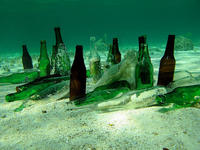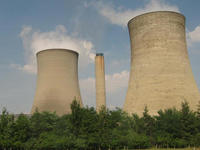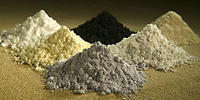-
Waste glass cleans up water

A simple method converts waste glass into a material which can be used to remove pollutants from contaminated water; the method uses colored glass which is being stockpiled in the United Kingdom as there is less recycling demand for green and brown bottles than there is for clear bottles
-
-
'Thinking machines' will run future power grids
Plans to develop the smart grid — a system that uses intelligent computer networks to manage electric power — cannot succeed without the creation of new “thinking machines” that can learn and adapt to new situations, from power outages along the grid to fluctuations in the power supply
-
-
Creating incentives to purchase disaster insurance
Natural disasters have become more common and more expensive – still, death, injury, and financial losses can be reduced through incentives to purchase insurance and install protective measures
-
-
Engineering lessons of Fukushima
Many engineers and scientists are still examining what happened at Fukushima during the earthqyake and tsunami of 11 March; one group, a Tsunami Loads-and-Effects Subcommittee sponsored by the American Society of Civil Engineers (ASCE), is preparing to publish early next year an approximately 350-page report
-
-
Blackberry service disruption spreads across North America
Research in Motion announced earlier today that the 3-day disruption of the company’s e-mail services has now spread across North America; it is the worst such disruption of service in two years; analysts say it is a major blow to the already-struggling company; not only individuals, but also private companies and government agencies may now reconsider their reliance on Blackberrys as their preferred mode of communication
-
-
U.K. nuclear plants are safe: report

The United Kingdom has finalized a review of the implications of the Fukushima disaster for the U.K. nuclear power industry; Dr. Mike Weightman, the author of the review, said that the “U.K. nuclear facilities have no fundamental safety weaknesses”
-
-
Calif. Allows warrantless searches of cell phones

California Governor Jerry Brown has vetoed a bill which aimed to prohibit California police from conducting warrantless searches of the cell phones of people under arrest
-
-
Reducing exposure to groundwater arsenic
Well diggers in Bangladesh will soon be able to take advantage of a cell phone-based data system, developed at the Earth Institute, to target safe groundwater aquifers for installing new wells that are not tainted with arsenic
-
-
Rising political, economic tensions over critical minerals

The clean energy economy of the future hinges on many things, chief among them the availability of the scores of rare Earth minerals and other elements used to make everything from photovoltaic panels and cellphone displays to the permanent magnets in cutting edge new wind generators; trouble is, China currently controls about 97 percent of the mining and production of the minerals, and it is using that control to give Chinese companies an advantage and for political pressure on other countries
-
-
Virus movement in Wisconsin groundwater
Drinking water taken from a deep aquifer protected by a semi-permeable layer of rock should be safe because the water is protected from many contaminants, including viruses — but is it safe? University of Wisconsin scientists find virus particles in many deep Madison, Wisconsin water wells, raising questions about how viruses, which should not survive more than two years underground, reached so deep and survive for so long
-
-
Siemens chosen to build Fort Collins's electrical smart grid
Siemens Energy, Inc. was recently chosen by the city of Fort Collins, Colorado to help build its electrical smart grid infrastructure
-
-
Smartphones now capable of detecting gas
Last week the DHS Science and Technology division showcased its latest invention, a smartphone capable of detecting dangerous gases; The device is capable of issuing an alarm to wake the phone’s owner, sending a text message to warn emergency contacts, or dialing 911 if dangerous amounts of carbon dioxide are detected
-
-
Survey finds small biz unprepared for cyber attacks
A recent survey found that many small businesses are not prepared for cyber threats and potential data breaches
-
-
Infrax System, Defendec to distribute Smartdec systems in U.S.
Smartdec System provides offers a solution for securing critical infrastructure assets; the battery-powered wireless system detects intruders on the perimeter of remote sites and helps to prevent vandalism, terrorism attacks, thefts, and accidents
-
-
Securing financial infrastructure against cyberattacks
To protect the U.S. financial sector from increasingly ubiquitous and costly cyberattacks, DHS plans to work more closely with other federal agencies as well as the private sector to defend against hackers
-
More headlines
The long view
Water Wars: A Historic Agreement Between Mexico and US Is Ramping Up Border Tension
As climate change drives rising temperatures and changes in rainfall, Mexico and the US are in the middle of a conflict over water, putting an additional strain on their relationship. Partly due to constant droughts, Mexico has struggled to maintain its water deliveries for much of the last 25 years, deliveries to which it is obligated by a 1944 water-sharing agreement between the two countries.
Trump Is Fast-Tracking New Coal Mines — Even When They Don’t Make Economic Sense
In Appalachian Tennessee, mines shut down and couldn’t pay their debts. Now a new one is opening under the guise of an “energy emergency.”
Smaller Nuclear Reactors Spark Renewed Interest in a Once-Shunned Energy Source
In the past two years, half the states have taken action to promote nuclear power, from creating nuclear task forces to integrating nuclear into long-term energy plans.
Keeping the Lights on with Nuclear Waste: Radiochemistry Transforms Nuclear Waste into Strategic Materials
How UNLV radiochemistry is pioneering the future of energy in the Southwest by salvaging strategic materials from nuclear dumps –and making it safe.
Model Predicts Long-Term Effects of Nuclear Waste on Underground Disposal Systems
The simulations matched results from an underground lab experiment in Switzerland, suggesting modeling could be used to validate the safety of nuclear disposal sites.
